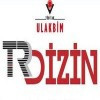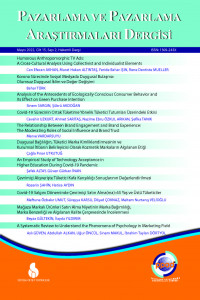Research Article
Aim & Scope
Journal of Marketing and Marketing Research has the purpose of examining the theoretical marketing topics and the marketing practices of businesses in theory; also revealing the results for the decision making, process management and activities of the enterprises with theoretical knowledge and findings. It also has the purpose of explaining how the findings for business managers can be used in practice with the data obtained from the factors that make up the market. In addition, it is among the objectives of the Journal of Marketing and Marketing Research to create a comprehensive platform for the publication of scientific studies that will contribute to the development of marketing and marketing research disciplines at the national and international level, and to shed light on sectoral activities related to marketing.
Journal of Marketing and Marketing Research is a peer-reviewed journal, published in Turkish and English, for marketing academics and practitioners in the field of marketing and marketing research. Our journal publishes empirical, descriptive and theoretical studies in all sub-fields of marketing such as consumer behavior, international marketing, service marketing, digital marketing, marketing research, and sustainability marketing, both theoretically and practically.
Author Guidelines
General Rules:
1. The Journal of Marketing and Marketing Research is published three times a year (January, May, and September).
2. Submission to The Journal of Marketing and Marketing Research are made using Dergipark Manuscript Management System (https://dergipark.org.tr/en/pub/ppad).
3. Each manuscript should follow National and International research and publication ethics rules. Manuscripts submitted to the journal should not have been published before or be under consideration for publication with another journal.
4. The length of the manuscripts should not exceed 8,000 words, including tables and figures, excluding bibliography.
5. If the manuscripts are accepted for publication, The Journal of Marketing and Marketing Research has all rights of publication.
6. The authors are required to register Dergipark Manuscript Management System providing their titles, affiliations correspondence addresses, phone numbers and e-mails. However; blind manuscripts should be uploaded to the Manuscript Management System.
7. Each manuscript is first reviewed by the editorial board and, if it is judged suitable for this publication, it is then sent to two reviewers for double-blind peer review. According to the reports of reviewers, the manuscript is decided for the publication, rejection and/or revision or sent to a third reviewer. The authors will be reported for the final decision on the manuscript.
8. The Journal considers manuscripts written both in Turkish and English. For the manuscripts whose written language is Turkish, the Turkish and English Abstract, consisting of maximum 200 words, should be written on a separate page. Likewise, in manuscripts whose language is Turkish, the title of the manuscript should be added to the in Turkish and English, and at least 3 keywords should be specified, again in Turkish and English.
9. Manuscripts written in English and English abstracts and extended abstracts must be proofreading.
10. In order for the accepted manuscripts to be published, the copyright agreement must be filled and sent to our journal.
11. All kinds of qualitative and quantitative studies that require data collection from the participants by using survey, interview, focus group, observation, experiment, and interview techniques, and whose data have been collected since January 2020, are required to upload the Ethics Committee reports to the system.
12. The reports from plagiarism programs of all manuscripts must be uploaded to the Dergipark system together with the manuscript. Studies with a maximum similarity rate of 15% in the reports will be accepted into the referee evaluation process.
Writing Rules:
1. The main body of the manuscript should be written in Word format (Times New Roman), with 1.5 line spacing and 11 pt.
2. Abstracts (in Turkish and English) should be written in 10 pt. and in Times New Roman format.
3. The bibliography must be written with single line spacing, in 11 pt. and in Times New Roman format.
4. The expressions in the tables and figures should be written in 9 pt. and in Times New Roman format. Tables and Figures in the text should be center aligned. Table headings should be placed above the table, and figure headings should be placed below the figure.
Tables should be numbered in Times New Roman format, bold and 11 pt.. (Table 1.). Table headings should be written in Times New Roman and in non-bold format and in the title case.
5. The title of the article should be written in uppercase, Times New Roman, 11 pt., bold, and center aligned. All chapter headings, including the introduction and the conclusion parts of the article, should be written in bold format, only the first letters should be uppercase and numbered as 1.; 1.1.; 1.1.1.; 1.1.1.1. Other headings should be written in italics.
6. For the decimal numbers, the rules of the language of the manuscript (English or Turkish) should be followed. For Turkish, it should be written as “,05”; for English as “.05”. The non-decimal numbers should be as 9.900 (nine thousand nine hundred) for Turkish; 9,900 (nine thousand nine hundred) for English. Equations should be center aligned with their sequence numbers in parentheses and right aligned.
Extended Abstract:
• For manuscripts written in Turkish, the Extended Abstract in English should be placed at the end of the study so that our journal can also be indexed in foreign literature. The sub-headings that should be included in the extended summary are as follows:
o Introduction
o Conceptual / Theoretical Framework
o Method
o Findings and Discussion
o Conclusion and Recommendations
• Extended Summary, Figures, Tables etc. It should be prepared and added to the end of the article, not exceeding 1500 words.
• Extended English abstracts must be proofreaded.
References and Bibliography:
• References in the text and in the bibliography should comply with APA (American Psychological Association) style (https://apastyle.apa.org/style-grammar-guidelines/references/examples/journal-article-references).
• References in the text should be shown in the parenthesis. The bibliography should be prepared in accordance with this reference style
Ethical Principles and Publication Policy
The Journal of Marketing and Marketing Research compiles with ethical rules in article acceptance and publication. In this context, the Publication Ethics Guidelines of the Committee on Publication Ethics (COPE) and the Scientific Research and Publication Guidelines of YÖK are accepted and implemented. Details of the COPE Directive can be found at; https://publicationethics.org/ and to YÖK Scientific Research and Publication Ethics Directive at; https://www.yok.gov.tr/Sayfalar/Kurumsal/mevzuat/bilimsel-arastirma-ve-etik-yonetmeligi.aspx
1. Practice Guidelines for Publishers
I. The Journal Publishers should ensure and protect the independence of the editorial board decisions without being under the influence of the journal's individuals or commercial partners.
ii. The Journal Publishers should protect the copyright of all published articles and make sure that they are registered.
iii. The Journal Publishers should make sure that the journal was published in accordance with the rules of research and publication ethics.
iv. The Journal Publishers should not interfere with the editors who decide that the articles that comply with the purpose, scope and publication ethics of the journal will be published.
v. The Journal Publishers should encourage the adoption of a system of publishing ethics that ensures that measures are taken against possible plagiarism, ensures that ethical standards are not compromised and prevents plagiarism.
2. Practice Guidelines for Editors
I. Editors, by providing a fair peer review process for reviewing articles published in the journal, should ensure that the work is evaluated by qualified people.
ii. Editors should ensure that the manuscripts submitted to the journal are evaluated without any prejudice and should take care not to discriminate in terms of gender, ethnicity, religious belief, political opinion while performing their duties.
iii. Editors should keep abreast of research and innovation related to publishing and peer review and should encourage relevant people to do so.
iv. Editors, if any, should strive to resolve problems and meet the expectations of readers, authors, and reviewers,
v. Editors should not allow potential conflicts of interest among themselves, as well as possible conflicts of interest between authors, reviewers and editorial board members.
vi. Editors can apply the necessary sanctions in cases of possible plagiarism.
vii. Information about the studies submitted to the journal should only be shared with people authorized by the editor.
3. Practice Guidelines for Peer Reviewers
I. Peer Reviewers should only accept evaluating of studies related to their field of expertise among the articles submitted to the journal.
ii. Peer Reviewers should be fair and impartial when evaluating the work submitted to the journal and should make their evaluations in a timely manner.
iii. When reviewing the work for which the reviewers are responsible, peer reviewers should always take care to make their comments in a proper, descriptive and objective manner. In studies with negative results, reviewers should indicate the deficiencies and flaws of the study in a concrete and detailed manner in their reports.
iv. Peer Reviewers should clearly inform the editor / editors about their possible research and publication plagiarism in the studies they review.
v. Peer Reviewers should report potential conflicts of interest, if any, to the editor before evaluating a study.
vi. Peer Reviewers should decline the evaluation of works for commercial purposes and report to the editor / editors.
vii. Peer Reviewers should regularly review the reviewer’s practice in order to best adapt to the peer review processes improvements.
4. Practice Guidelines for Authors
It is assumed that the authors who submit articles to the journal have read and accepted the ethical rules and publication principles of the journal.
According to the YÖK Scientific Research and Publication Ethics Directive, the main actions against scientific research and publication ethics that authors have to avoid are:
a. Plagiarism: Showing others' original ideas, methods, data or works as their own work, partially or completely, without reference to scientific rules,
b. Forgery: Using data that does not actually exist or has been falsified in scientific research,
c. Distortion: Falsifying the research records or data obtained, showing the devices or materials not used in the research as being used, distorting or shaping the results of the research in the interests of the people and organizations that are supported,
d. Republishing: To present repetitive publications as separate publications in academic appointments and promotions,
e. Slicing: To present these publications as separate publications in academic appointments and promotions by dividing the results of a research into pieces in a way that disrupts the integrity of the research and inappropriately and publishing them in more than one issue.
f. Unfair Writing: Including non-active contributors among the authors or not including those who are, changing the author's order in an unjustified and inappropriate manner, removing the names of those with active contributions from the work in subsequent editions, using their influence to include their names among the authors,
g. Conflict of Interest: Not specifying the supporting individuals, institutions or organizations and their contributions in the publications made as a result of research conducted with support.
h. Using thesis or studies that have not yet been submitted or have not been accepted as a source without the permission of the owner,
I. Not complying with ethical rules in research on humans and animals, not respecting patients' rights in publications,
j. To act contrary to the provisions of the relevant legislation in biomedical research and other clinical research related to humans,
k. Sharing the information contained in a work that has been assigned to review with others before it is published without the explicit permission of the owner of the work,
l. Misusing resources, venues, facilities and devices provided or allocated for scientific research
m. To accuse flimsy, unwarranted and deliberate ethical violations,
n. To publish the data obtained without the explicit consent of the participants in the survey and attitude research conducted as part of a scientific study, or if the research will be conducted in an institution, also without the permission of the institution
o. Harm animal health and ecological balance in research and experiments,
p. Failing to obtain written permissions from the authorized units in research and experiments, which must be obtained before starting work,
q. Conduct research and experiments in violation of the provisions of the legislation of international conventions to which Turkey is a party on relevant research and experiments
r. Failure to comply with the obligation to inform and warn those concerned about possible harmful practices related to scientific research conducted by researchers and authorities,
s. Not to use data and information obtained from other individuals and institutions in scientific studies to the extent and as permitted, not to respect the confidentiality of this information and to ensure its protection,
t. To make false or misleading statements regarding scientific research and publications in academic appointments and promotions.
On the other hand, the studies submitted by authors to the journal will be examined in "Ithenticate" or "Turnitin" programs. Studies with a similarity rate of more than 20% or with any of the above-mentioned unethical rules will not be accepted.
If plagiarism is detected in a study, the first step taken by the editorial board is to contact the authors and report that plagiarism that has been detected. If the authors admit their mistakes, the article will be rejected, and will be forwarded to the authors' institution. If plagiarism is detected after the study has been published, the authors must confess to the journal about this situation. Editors have the right to cancel the work after taking due care and confirming plagiarism. Authors can be blacklisted by the journal and all affiliated (member) journals will be informed. In addition, if authors refuse plagiarism, editors can take appropriate action within the scope of the COPE guidelines.
Price Policy
There is no Article Processing Charge (publication fee)
Indexes
Citation Indexes
Other Indexes
Journal Boards
Editör

Editör Yardımcıları
Dil Editörü ve Sekreterya

Editör Kurulu

Her research has been published in leading peer-reviewed academic journals such as Studies in Higher Education, Journal of Research in Interactive Marketing, Journal of Retailing and Consumer Services, Humanities and Social Sciences Communications, and Behaviour & Information Technology. Prof. Dr. Öztürkcan is also a member of the Harvard Business Review Advisory Council and the Circular Economy Group of the Baltic University Programme.
For more information on her publications and academic contributions, please visit the following links:
• Personal Website: www.selcenozturkcan.com
• Sabancı University Faculty Profile: https://sbs.sabanciuniv.edu/tr/faculty-members/detail/1112
• Linnaeus University Faculty Profile: https://lnu.se/en/staff/selcen.ozturkcan/





Feray Adıgüzel, Nottingham Trent Üniversitesi Nottingham Business School'da Pazarlama alanında kıdemli öğretim görevlisidir. Nottingham Business School'a katılmadan önce Amsterdam'daki VU Üniversitesi'nde, Rotterdam'daki Erasmus Üniversitesi'nde ve Roma'daki Luiss Üniversitesi'nde çalıştı. Journal of Marketing Research, International Journal of Research in Marketing (IJRM), Journal of Economic Psychology, Journal of Business Research gibi önde gelen bilimsel dergilerde yayınları bulunmaktadır. Michalek, J., Ebbes, P., Feinberg, R.E. ile birlikte çalıştığı makale. & Papalambros, P. 2011 IJRM En İyi Makale ödülünü aldı.
Feray Adıgüzel is a senior lecturer in Marketing at Nottingham Business School, Nottingham Trent University. Before joining to Nottingham Business School, she worked at VU University in Amsterdam, Erasmus University in Rotterdam, and Luiss University in Rome. She has published in leading scientific journals such as Journal of Marketing Research, International Journal of Research in Marketing (IJRM), Journal of Economic Psychology, Journal of Business Research etc. The paper that she collaborated with Michalek, J., Ebbes, P., Feinberg, R.E. & Papalambros, P. was received 2011 IJRM Best paper award.
Danışma Kurulu

Her research has been published in leading peer-reviewed academic journals such as Studies in Higher Education, Journal of Research in Interactive Marketing, Journal of Retailing and Consumer Services, Humanities and Social Sciences Communications, and Behaviour & Information Technology. Prof. Dr. Öztürkcan is also a member of the Harvard Business Review Advisory Council and the Circular Economy Group of the Baltic University Programme.
For more information on her publications and academic contributions, please visit the following links:
• Personal Website: www.selcenozturkcan.com
• Sabancı University Faculty Profile: https://sbs.sabanciuniv.edu/tr/faculty-members/detail/1112
• Linnaeus University Faculty Profile: https://lnu.se/en/staff/selcen.ozturkcan/

Yuksel Ekinci is a Professor of Marketing at the Faculty of Business and Law, University of Portsmouth. His research focuses on destination branding, Consumer-Based Brand Equity, and global marketing strategy. His scholarly work has been widely published in leading academic journals, including the Journal of Travel Research, Annals of Tourism Research, Tourism Analysis, Tourism Management, Journal of Business Research, European Journal of Marketing, and Psychology & Marketing. Additionally, Yuksel serves on the editorial boards of several prominent journals in tourism and marketing, such as the Journal of Retailing and Consumer Services and the Journal of Travel Research.

Professor Dr. Selçuk Burak Haşıloğlu, whose area of expertise is marketing information systems, has been conducting academic studies since 1993. He holds a bachelor's degree in mathematics and two master's degrees in business and computer engineering, and completed his doctorate in 2006 at Gazi University's Department of General Business. The focus of both his master's and doctoral theses is on e-commerce and marketing information systems, with their research being among the first of its kind in the country.In 2009, he successfully completed his postdoctoral studies, which he conducted for a period of one year at the Henley Business School Informatics Research Centre at the University of Reading in England. During this period, he was awarded the Science Award by the Undersecretariat of Foreign Trade of the Prime Ministry of the Republic of Turkey.He has received six scholarships/awards to date, and has authored over 10 books on digital marketing, business and marketing information systems.He has conducted over 100 scientific studies, and played an active role in over 20 projects, including three TUBITAK and two ministry projects. He was awarded associate professorship in marketing science in 2011 and became a professor in 2017.His research is focused on marketing research, marketing analytics, data science and mining, decision analysis, decision sciences and digital marketing.He has served as president of the Marketing and Marketing Research Association and the Chess Clubs Federation, and has participated in numerous social responsibility projects. He has been serving as the general secretary at Pamukkale University since 1995, and has held administrative positions such as faculty management and faculty board memberships, technopark board memberships, department heads, university commission memberships. Haşıloğlu is a consultant in the private sector, specialising in blockchain, game world, mathematical economy and dynamics, big data analysis and analytics, marketing research, business intelligence and information systems management. He is currently employed at the Pamukkale University Department of Management Information Systems, which he established.
Teknik Editör









